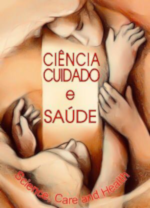Moral distressof radiological technologistsin conventional radiology service in Santa Catarina
Abstract
Introduction: The use of ionizing radiation in medical practice may cause harm to the health of the exposed individual. Thus, the ethical use of ionizing radiation must contemplate what is required by national and international legislation, as well as the principles of radiological protection and bioethics. Moral distress is related to the ethical dimension in health practice, and may affect radiological technologists. Objective: To identify the situations that trigger moral distress among radiological technologistsin a conventional radiology service. Methodology: This is a qualitative, descriptive and exploratory research. Data collection techniques were participant observation, semi-structured interview and consensus validation. Data were analyzed through thematic analysis. Results and discussion: Situations of moral distress were observed when the radiological technologist was faced with patients in clinical conditions to go to the diagnostic and imaging unit, due to the non-clinical indication of the radiological exam, due to the disrespect of the protection principles and lack of autonomy to enforce the ethical precepts of the use of ionizing radiation. Conclusion: Failure to respect the legal principles as well as the principles of radiological and bioethical protection lead the professional of radiological techniques to moral distress.
Downloads
References
Castro CCL, Gico VV. Submissão a exames de raios x de candidatos a cargo público à luz dos princípios da proteção radiológica. RevUni-RN [Internet]. 2014 [citado em 07 nov. 2019];13(1/2):173-196. Disponível em: http://revistas.unirn.edu.br/index.php/revistaunirn/article/view/342/288
Huhn A, Vargas MAO. Plano de proteção radiológica e responsabilidade ética. Braz J radiatsci. [Internet] 2016 [citado em 07 nov. 2019]; 4(1):1-7. Disponível em https://www.bjrs.org.br/revista/index.php/REVISTA/article/view/184/159
International Commissionon Radiological Protection. Ethical Foundations ofthe System of Radiological Protection. Ottawa: [Internet] 2018 [citado em 07 nov. 219]. Available from: https://journals.sagepub.com/doi/pdf/10.1177/0146645317746010
Brasil. Secretaria de Vigilância Sanitária do Ministério da Saúde. Portaria n. 453, de 1º de junho de 1998. Diretrizes de proteção radiológica em radiodiagnóstico médico e odontológico. Diário Oficial da União. Brasília, DF: Ministério da Saúde; [citado em 07nov. 2019] 1998. Disponível em https://saude.es.gov.br/Media/sesa/NEVS/Servi%C3%A7os%20de%20sa%C3%BAde%20e%20de%20interesse/portaria453.pdf
Malone J, Zölzer F. Pragmatic ethical basis for radiation protection in diagnostic radiology. Br J Radiol.[on-line] 2016 [citado em 07 nov. 2019];89(1059):1-13. doi: http://dx.doi: 10.1259/bjr.20150713
Doudenkova V, Pipon JB. Duty to informand in formed consent in diagnostic radiology: howe thic sandlaw can better guide practice. Hec Forum. 2015; 28(1):75-94. doi: https://link.springer.com/article/10.1007%2Fs10730-015-9275-7
Reisz JA, Bansal N, Qian J, Zhao W, Furdui CM. Effectas of ionizing radiation on biological molecules – mechanisms of damagem and emerging methods of detection. Antioxid Redox Signal, 2014; 21 (2): 260-292. doi: https://doi.org/10.1089/ars.2013.5489
Friedman AA, Ghani KR, Peabody JO, Jackson A, Trinh QD, Elder JS. Radiation Safety Knowledge and Practices Among Urology Residents and Fellows: Results of a Nationwide Survey. J SurgEducat. 2013;70(2):224-31. doi: https://doi.org/10.1016/j.jsurg.2012.10.002
Fidan F, Umit MC, Kazdal C, Kjlic F, Ozkaya U. Behavior and knowledge skill levels of orthopedic surgeons about radiation safety and fluoroscopy use: a survey analysis. Acta Orthop Traumatol Turc. 2019; 53 (4), 301-305. doi: https://doi.org/10.1016/j.aott.2019.04.008
Hirvonen L et al. Nurses’ knowledge of radiation protection: A cross-sectional study. Radiography. 2019; 25, 108-112. doi: https://doi.org/10.1016/j.radi.2019.04.011
Szarmach A et al. Radiation safety awareness among medical staff. Pol J Radiol. 2015. 80; 57-61. doi: http://dx.doi.org/10.12659/PJR.892758
Jameton A. Nursing practice: the ethical issues. Englewood Cliffs: Prentice-Hall; 1984.
Barlem ELD, Lunardi VL, Lunardi GL, Tomaschewski-Barlem JG, Silveira RS, Dalmolin GL. Sofrimento moral em trabalhadores de enfermagem. Rev Latino-AmEnferm. 2013; 21(Spec):1-9. doi:https://doi.org/10.1590/S0104-11692013000700011
Silveira LR, Ramos FRS, Schneider DG, Vargas MAO, Barlem ELD. Moral suffering in nurses of inspection departments in Brazil. 2016; 29 (4): 454-462. doi: http://dx.doi.org/10.1590/1982-0194201600062
Guest G, Bunce A, Johnson L. How many interviews are enough?: an experimente with data saturation and variability. Field Meth. 2006;18(1):59-82. doi: https://doi.org/10.1177/1525822X05279903
Oddone I. Ambiente de trabalho: a luta dos trabalhadores pela saúde. São Paulo: Hucitec; 1986.
Braun V, Clarke V. Using thematic analysis in psychology. Qual Res Psychol. 2006;3(2):77-101. doi: https://www.tandfonline.com/doi/abs/10.1191/1478088706qp063oa
Leuraud K et al. Ionising radiation and risk of death from leukaemia and lymphoma in radiation-monitored workers. Lancet Haematol. 2015; Jul;2(7):e276-281. doi: http://dx.doi:10.1016/S2352-3026(15)00094-0
International Commission on Radiological Protection. Raccomandazioni Della Commissione Internazionale per La Protezione Radiologica. Annals of the ICRP [Internet] 2008 [citad 2019 nov]; 37(2-4):1-287. Available from: http://www.icrp.org/docs/P103_Italian.pdf
Ramos FRS, Vargas MAO, Schneider DG, Barlem ELD, Scapin SQ, Schneider AMM. Ethical conflict as a trigger for moral suffering: survey of Brazilian nurses. Rev Enferm Uerj. 2017; 25:1-5. doi: https://doi.org/10.12957/reuerj.2017.22646
Briesi G, Lunardi VL, Azambuja EP, Kerber NPC. Moral distress of health community agentes. Ciênc. cuid. saúde. 2015; 14(2): 1035-1042. doi: https://doi.org/10.4025/cienccuidsaude.v14i2.17696
Schaefer R, Zoboli ELCP, Vieira M. Moral distress in nurses: a description of the risks for professionals. Texto & contexto enferm. 2018 ;27(4):1-10. doi: http://dx.doi.org/10.1590/0104-07072018004020017
Navarro MVT, Costa EA, Drexler GG. Radio diagnostic risks control: an approach of sanitary surveillance. Ciênc Saúde Colet. 2010;15(3):3477-86. doi: http://dx.doi.org/10.1590/S1413-81232010000900022
Madrigano RR, Abrão KC, Puchnick A, Regacini R. Evaluation of non-radiologist physicians’ knowledge on aspects related to ionizing radiation in imaging. RadiolBras. 2014;47(4):210-6. doi: http://dx.doi.org/10.1590/0100-3984.2013.1840
Compagnone G, Padovani R, D’Avanzo MA, Grande S, Campanella F, Rosi A. Summary of the Italian inter-society recommendations for radiation protection optimization in interventional radiology. La Radiol Med. 2018 ;123(5):378-84. doi: https://doi.org/10.1007/s11547-017-0849-0
Copyright (c) 2020 Ciência, Cuidado e Saúde

This work is licensed under a Creative Commons Attribution-NonCommercial 4.0 International License.





















